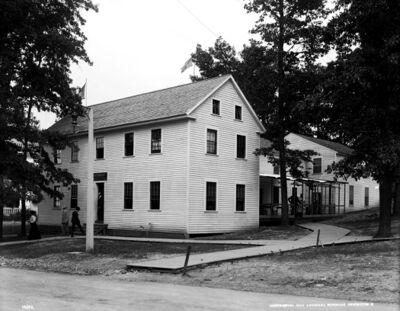Vermont
 | |
| Location | Plateau of States |
|---|---|
| Construction | |
| Construction Cost | $5,000 ($150,796 in 2021) |
| Dates | |
| Special Day | Thanksgiving Day |
| Architecture | |
| Architect | Arthur C. Jackson |
| Dimensions | 50' x 100' |
The old Constitution House, standing in Windsor, was reproduced as the State building of Vermont. The original building Is the house where the Constitution of Vermont was drawn up and signed. It was located on the Plateau of States.
Etymology
Across the hall is another of modern embellishment. There the dark green stained woodwork and fashionable burlap mark it as of the present period. Here, too, is placed another of those Conover new system upright pianos which lend themselves so well to architectural embellishment.
Before the Fair
The legislature having failed to make an appropriation for Vermont, State Commissioner President, Arthur C. Jackson, a native of Waitsfield, personally raised all the money required for the construction and maintenance of the building.
Description
Vermont's state building was a reproduction of `The Old Constitution House,' standing in Windsor, though at the time of the Fair, it was being used as a warehouse. The original building, an inn, was the house where the Constitution of Vermont was drawn up and signed.
The State Association reproducing it has as one of its objects the preservation and restoration of the original, which at the time of the Fair was being used as a warehouse. The caretaker of the reproduction is E. G. Flanders
The exterior of the building was done in weatherboard, a striking difference from the other state buildings.
The main room was furnished in antique style and used for the reception of guests.
The rear portion is a large restaurant, and has long been torn away from the original. In the front structure this room to the right, with its center table from 1750, its antique closet of mahogany with dark blue and aged chinaware, and its old spinning wheel, is true to the period of the Constitution House.
Across the hall is dark green stained woodwork and fashionable burlap mark, popular in the early 1900s.
